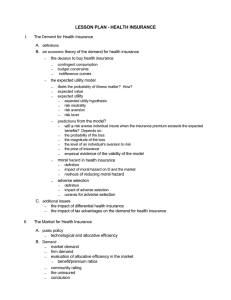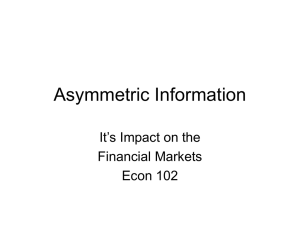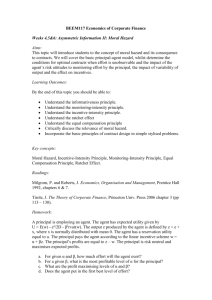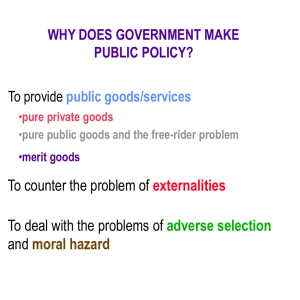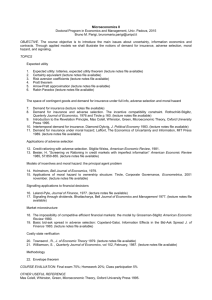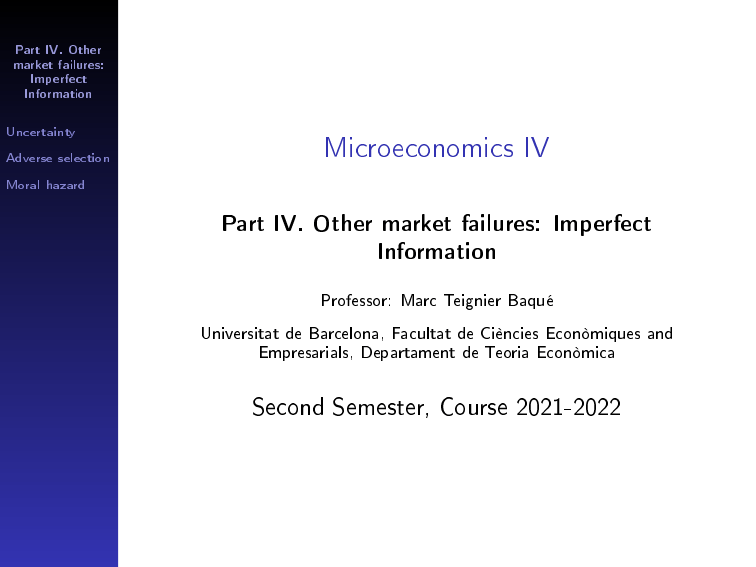
Part IV. Other
market failures:
Imperfect
Information
Uncertainty
Adverse selection
Moral hazard
Microeconomics IV
Part IV. Other market failures: Imperfect
Information
Professor: Marc Teignier Baqué
Universitat de Barcelona, Facultat de Ciències Econòmiques and
Empresarials, Departament de Teoria Econòmica
Second Semester, Course 2021-2022
Part IV. Other
PART IV. IMPERFECT INFORMATION
market failures:
Imperfect
Information
Uncertainty
Adverse selection
Moral hazard
I
First Welfare Theorem: all competitive equilibrium
allocations are Pareto ecient
(invisible hand mechanism).
I
Assumptions behind it:
I
I
I
I
markets are competitive,
no externalities,
perfect information.
Market failures:
I
I
I
consumption/production externalities,
public goods,
asymmetric information.
Part IV. Other
Part III Contents
market failures:
Imperfect
Information
Uncertainty
Contingent BC
Preferences
Choice
Insurance
Diversication
Adverse selection
Moral hazard
1. Choice under uncertainty
1.1 State-contingent budget constraints
1.2 Preferences under uncertainty
1.3 Choice under uncertainty
1.4 Fair insurance
1.5 Risk diversication
2. Asymetric information: adverse selection
3. Asymetric information: moral hazard
Part IV. Other
market failures:
Imperfect
TOPIC 9. CHOICE UNDER UNCERTAINTY
I
Information
Uncertainty
Contingent BC
Preferences
Choice
Insurance
Diversication
Adverse selection
Moral hazard
So far, optimization problems considered had no
uncertainty.
I
However, in the real world people often make decisions
with uncertainty about future prices, future wealth, or
other agents' decisions.
I
In this section, we study the choice problem under
uncertainty using a two-state version of our consumer's
choice model.
I
Optimal responses: insurance purchase, risk
diversication.
I
Example:
I
2 possible states of nature: car accident (loss of
L¿),
no car accident.
I
I
Probabilities for each state:
Insurance: get
K¿
insurance premium.
πa , πna .
if accident by paying
γK ¿
as
Part IV. Other
State-contingent budget constraints
market failures:
Imperfect
Information
Uncertainty
Contingent BC
Preferences
Choice
Insurance
Diversication
Adverse selection
Moral hazard
Denitions
A contract is
state contingent
if it is implemented only
when a particular state of Nature occurs.
A
state-contingent consumption plan
species the
consumption to be implemented when each state of Nature
occurs.
I
Example:
I
I
Consumption if no accident:
cna = M − γK
Consumption if accident:
ca = M − L − γK + K ⇒ K =
ca −M +L
1−γ
ca − M + L
1−γ
γ
M − γL
⇔ cna =
−
ca
1−γ
1−γ
⇒ cna = M − γ
Part IV. Other
market failures:
Imperfect
Information
Uncertainty
State-contingent budget constraints
Car Insurance example
I
State-contingent budget constraint in car insurance
example:
Contingent BC
Preferences
Choice
Insurance
Diversication
Adverse selection
Moral hazard
cna =
γ
m − γL
−
ca
1−γ
1−γ
| {z } | {z }
intercept slope
Cna
Bundle with no consumption if accident: K
M
LM
1
Endowment bundle
Full insurance bundle (Ca =Cna )
Bundle with no consumption if
no accident: K M
M‐L
Ca
Part IV. Other
market failures:
Imperfect
Preferences under Uncertainty
I
Information
their preferences about the dierent state-contingent
Uncertainty
Contingent BC
Preferences
Choice
Insurance
Diversication
Adverse selection
Moral hazard
To know what is the agents' choice, we need to know
consumption plans.
I
Utility across state-contingent consumption plans is a
function of the consumption levels and probabilities at
each state,U (c1 , c2 , π1 , π2 ).
Denition
A utility function
utility
or
U (c1 , c2 , π1 , π2 )
satises the
von NeumannMorgenstern
expected
property if it can be
written as the weighted sum of the utility at each state,
where the weights are the probabilities of each state:
U (c1 , c2 , π1 , π2 ) = π1 v (c1 ) + π2 v (c2 )
It satises the independence property, which means that the
utility in a given state is independent of the utility in other
states.
Part IV. Other
Risk aversion
market failures:
Imperfect
Information
Uncertainty
Contingent BC
Preferences
Choice
Insurance
Diversication
Denition
We say an agent is
risk averse
if the expected utility of
wealth is lower than the utility of expected wealth,
if it is higher, and
I
Adverse selection
Moral hazard
risk neutral
Example:
I
I
I
I
Lottery: 90
risk lover
if it is equal.
¿ with probability 1/2, 0¿ with prob 1/2.
Utility levels: U($90) = 12, U($0) = 2.
Expected utility: EU=1/2*12+1/2*2=7.
Expected money value: EM=1/2*90+1/2*0=45.
Risk lover consumer
Risk averse consumer
Risk neutral consumer
12
12
EU 7
EU=7
U(45) EU 7
U(45)=EU=7
12
U(45)
EU=7
U(45)
2
2
0
45
90
W lh
Wealth
2
0
45
90
Wealth
0
45
90
Wea
Part IV. Other
Indierence Curves
market failures:
Imperfect
Information
I
expected utility are equally preferred and on the same
Uncertainty
Contingent BC
Preferences
Choice
Insurance
Diversication
Adverse selection
Moral hazard
State-contingent consumption plans that give equal
indierence curve.
I
Slope of indierence curves:
EU = π1 U (c1 ) + π2 U (c2 ) ⇒ dEU = π1
π1
∂ U (c1 )
∂ U (c2 )
dc1 + π1
dc2
∂ c1
∂ c2
π1 ∂ U (c1 ) /∂ c1
∂ U (c1 )
∂ U (c2 )
dc2
dc1 + π2
dc2 = 0 ⇒
=−
∂ c1
∂ c2
dc1
π2 ∂ U (c2 ) /∂ c2
C2
Indifference curves
EU1 < EU2 < EU3
EU3
EU2
EU1
C1
Part IV. Other
market failures:
Imperfect
Choice under uncertainty
I
Information
Uncertainty
Contingent BC
Preferences
Choice
Insurance
Diversication
The optimal choice under uncertainty is the most
preferred aordable state-contingent consumption plan.
I
In the car insurance example, the optimal consumption
plan is where the slope of indierence curves is tangent
to the budget constraint:
Adverse selection
Moral hazard
γ
πa ∂ U (ca ) /∂ ca
=
πna ∂ U (cna ) /∂ cna 1 − γ
Cna
Most preferred affordable plan
m
Affordable plans
m L
m L
Ca
Part IV. Other
Fair insurance
market failures:
Imperfect
Information
Uncertainty
Contingent BC
Preferences
Choice
Insurance
Diversication
Adverse selection
Moral hazard
Denition
We say an insurance is
fair or competitive
if the expected
economic prot of the insurer is zero, or, equivalently, if the
¿ insurance is the probability of the insured state.
price of a 1
I
Car insurance example:
γK
|{z}
−πa K − (1 − πa ) 0
{z
}
|
= 0 ⇒ γ = πa
revenues expected expenditures
I
If the insurance is fair, the optimal choice of risk-averse
consumers is full insurance:
πa ∂ U (ca ) /∂ ca
πa
∂ U (ca ) ∂ U (cna )
=
⇒
=
πna ∂ U (cna ) /∂ cna 1 − πa
∂ ca
∂ cna
Hence, for risk averse consumers,
ca = cna .
Part IV. Other
market failures:
Imperfect
Information
Uncertainty
Contingent BC
Preferences
Choice
Insurance
Diversication
Adverse selection
Moral hazard
Unfair insurance
Unfair Insurance
Denition
We say an insurance is
unfair
if the insurer makes positive
expected economic prots.
I
If the insurance is unfair, the optimal choice of
risk-averse consumers is less than full insurance:
γK
|{z}
−π K − (1 − πa ) 0
| a
{z
}
>0⇒
revenues expected expenditures
Hence,
πa ∂ U(ca )/∂ ca
πna ∂ U(cna )/∂ cna
γ
= 1−γ
implies that
∂ U (ca ) ∂ U (cna )
>
∂ ca
∂ cna
so, for risk averse consumers,ca
< cna .
πa
γ
>
1−γ
πna
Part IV. Other
Diversication
market failures:
Imperfect
Information
I
Uncertainty
earnings in exchange for lowered risk. This is going to
Contingent BC
Preferences
Choice
Insurance
Diversication
Adverse selection
Moral hazard
Asset diversication typically lowers (or keeps) expected
be the case as long as the asset prices are not perfectly
correlated across states.
I
Example: two rms, two states (prob. 1/2), agent with
100
¿ to spend in rms' share.
I
¿, in state 2 20¿.
100
I
¿, prots per share in state 1
Firm A: shares' cost 10
¿, prots per share in state 1
Firm B: shares' cost 10
¿, in state 2 100¿.
20
Prots in 1
Prots in 2
Expected prots
10 shares of A
10 shares of B
5 of A, 5 of B
200¿
1000¿
600¿
1000¿
600¿
200¿
600¿
600¿
600¿
Part IV. Other
Part III Contents
market failures:
Imperfect
Information
Uncertainty
Adverse selection
Adverse selection
Signaling
Moral hazard
1. Uncertainty
2. Asymetric information: adverse selection and signaling
2.1 The model of Akerlof
2.2 Signaling
3. Asymetric information: moral hazard
Part IV. Other
ASYMETRIC INFORMATION
market failures:
Imperfect
Information
Uncertainty
Adverse selection
Adverse selection
Signaling
I
In the purely competitive markets, agents are assumed to
have perfect information about all the exchange aspects.
I
In some markets, however, this is clearly not realistic
(medical services, used cars, insurance...):
Moral hazard
I
I
A doctor knows more about medicine than the patient.
A used car seller has more information about the car
than the potential buyer.
I
The buyer of an insurance knows much more about
his/her risks than the insurer.
I
We say that a market suers from
information
imperfect
if one of the sides does not have all the
information about the exchange.
I
We say that a market suers from
information
asymetric
if one of the sides has more information
than the other.
Part IV. Other
Asymetric information ineciency
market failures:
Imperfect
Information
Uncertainty
Adverse selection
Adverse selection
Signaling
I
Under asymetric information, markets typically have less
transactions than under the perfect information
Moral hazard
equilibrium; hence, we say that the equilibrium under
asymetric information is inecient.
I
In this context, government intervention may be Pareto
improving but it may also be Pareto worsening.
I
The question is, then, whether government has more
information than market participants and whether the
costs associated to it are not too large.
Part IV. Other
Asymetric information applications
market failures:
Imperfect
Information
Uncertainty
Adverse selection
Adverse selection
Signaling
Moral hazard
I Adverse selection
refers to a situation where one of
the sides cannot observe all the characterstics of a good
(also known as
I Signaling
hidden quality problem ).
refers to a situation where the high/quality
agent takes actions to dierent him/herself from the
rest of agents.
I Moral hazard
refers to a situation where one of the
sides cannot observe the actions of the other side (also
known as
hidden action problem).
I Incentives contracting
consists on designing a system
of incentives to prevent agents from taking undesired
actions after the contract is signed.
Part IV. Other
TOPIC 10. ADVERSE SELECTION
market failures:
Imperfect
Information
Uncertainty
Adverse selection
I
Consider a used-cars market with two types of cars,
lemons and peaches:
I
Adverse selection
Signaling
The reservation price of lemons sellers is 1000, while
buyers are willing to pay 1200.
Moral hazard
I
The reservation price of peaches sellers is 2000, while
buyers are willing to pay 2400.
I
Therefore, when sellers have perfect information all the
cars get sold and the total surplus is positive:
I
Lemons are sold for an amount between 1000 and
1200.
I
Peaches are sold for an amount between 2000 and
2400.
I
But what happens when sellers do not know the car
type?
Part IV. Other
Akerlof model
market failures:
Imperfect
Information
Uncertainty
Adverse selection
I
If buyers cannot distinguish lemons and peaches (but they
know the proportions), how much are they willing to pay?
I
Adverse selection
Signaling
Let
q
denote the fraction of high-quality cars and 1 − q
the low-quality ones.
Moral hazard
I
Therefore, the expected value for the buyer is
V e = 1200(1 − q) + 2400q .
I
When
I
I
I
I
q
is such that
V e < 2000,
The high-quality sellers leave the market.
Only the low-quality sellers stay in the market.
Knowing this, buyers are only willing to pay 1200.
Hence, too many low-quality cars are expelled from the
market, which reduces the exchange surplus. In other words,
the presence of low-quality sellers imposes an external cost to
high-quality sellers and buyers.
Part IV. Other
Akerlof model (2)
market failures:
Imperfect
Information
Uncertainty
Adverse selection
Adverse selection
Signaling
I
How many low-quality cars are compatible with high-quality
cars remaining in the market?
Moral hazard
I
Buyers are willing to pay 2000 if q is such that
V e = 1200(1 − q) + 2400q ≥ 2000.
I Hence, if q < 13 , only low-quality cars are sold.
I
Pooling and seprating equilibrium:
I
In a
separating equilibrium
only of type of cars is
traded or each type is traded at a dierent price.
I
In a
pooling equilibrium
the same price.
both types of cars are sold at
Part IV. Other
Adverse selection with a continuum of types
market failures:
Imperfect
Information
Uncertainty
Adverse selection
I
If the car quality
x
is uniformly distributed between 1000 and
2000 and buyers are willing to pay
Adverse selection
Signaling
x + 300
for a car of quality
x.
Moral hazard
I
Which cars are traded in this case?
I
The expected quality is 1500 and the expected value for
sellers is 1500 + 300 = 1800.
I
I
Hence, sellers of quality above 1800 leave the market.
As a result, the expected value for the cars remaining in
the market becomes $1400 + $300 = $1700.
I
As a result, the sellers with quality between 1700 and
1800 abandon the market..
I
...
Part IV. Other
Adverse selection with a continuum of types (2)
market failures:
Imperfect
Information
Uncertainty
Adverse selection
I
Which cars will remain in the market?
I
Adverse selection
Signaling
Denote
vH
the quality (or seller's value) of the best car
in the carel valor.
Moral hazard
I
I
I
The expected quality of the cars in the market is, thus,
V e = 1000 + vH −21000 =
+ v2H .
Hence, the expected value for the seller is
1000
2
+ v2H + 300.
Since this will also be the highest quality in the market,
1000
2
I
1000
2
+
vH
2
+ 300 = vH ⇒ vH = 1600
Therefore the adverse selection expels all the cars with
quality above 1600.
Part IV. Other
Adverse selection with quality choice
market failures:
Imperfect
Information
Uncertainty
Adverse selection
Adverse selection
Signaling
Moral hazard
I
Suppose now that sellers can choose the quality of the
product they sell.
I
Example: two types of umbrellas, high quality and low quality
(not dierentiable for the consumer).
I
Buyers' valuation is 14 for the high quality and 8 for the
low quality.
I
Production cost is 11 for the high quality and 10 for the
low quality.
I
Is there any equilibrium in this market?
Part IV. Other
Adverse selection with quality choice (2)
market failures:
Imperfect
Information
Uncertainty
Adverse selection
I
Adverse selection
Signaling
Is it possible an equilibrium where only low-quality umbrellas
are sold?
I
Moral hazard
I
No, because sellers would have a benet equal to -2.
Is it possible an equlibrium where only the high-quality
umbrellas are produced?
I
If there are only high-quality umbrellas, buyers are
willing to pay 14 and sellers obtain a prot of 3.
I
But sellers can have a benet equal to 4 by producing
low quality umbrellas.
I
Hence, it is not possible to only have high-quality
producers.
Part IV. Other
Adverse selection with quality choice (3)
market failures:
Imperfect
Information
Uncertainty
Adverse selection
I
Is it possible to have an equilibrium where both types are
produced?
I
Adverse selection
Signaling
Let
q
denote the fraction of sellers producing high
quality, where 0
Moral hazard
I
< q < 1.
Then, the buyers' expected value is
V e = 14q + 8(1 − q) = 8 + 6q .
I
Since the high quality producers must have positive
prots, 8 + 6q
I
> 11q + 10 (1 − q) ⇒ q > 2/5.
But note that sellers can always increase their prots by
producing only low quality.
I
I
And when
q=0
buyers are only willing to pay 8.
There, an equilibrium with both types does not exist
either!
I
In this situation, the adverse selection problem completely
destroys the market!
Part IV. Other
market failures:
Imperfect
Signaling
I
Information
Uncertainty
Adverse selection
Adverse selection
Signaling
In a context with adverse selection, high-quality sellers have
an incentive to signal their quality:
I
I
Methods: reference letters, warranties, advertisement.
Example: labor market with high ability type and low ability
type.
Moral hazard
I
The marginal product of the high ability type is
aL < aH .
I The fraction of high ability workers is h, while
fraction of low ability workers i 1 − h.
the low ability type is
I
aL ,
aH
and
where
the
If rms can distinguish the two types (and workers are paid
their marginal product)
wH = aH , wL = aL .
I
But if rms cannot dierentiate the two types, they will oer
workers the expected marginal product:
wP = (1 − h)aL + haH .
I
Since
wP = (1 − h)aL + haH < aH ,
high-quality workers may
be willing to pay to send a credible signal.
Part IV. Other
market failures:
Imperfect
Information
Education as a signal
I
I
Uncertainty
Adverse selection
Denote the education cost by
workers and
I
Adverse selection
Signaling
Moral hazard
Workers may want to use education as a signal:
cL
cH
for high-education
for low-education workers, with
cL > cH .
Assume (just as a example!) that education does not
change the productivity of workers.
I
High-abilty agents want to get
eH
units of education if it
works as a signal:
I
the benet is higher than the cost for high-ability
workers:
I
wH − wL = aH − aL > cH eH ,
the benet is higher than the cost low-ability workers:
wH − wL = aH − aL < cL eH .
I
In this situation, high-ability workers want to get education
while low-ability workers do not.
I
Therefore, education is useful to signal the type.
I
Note that signaling solves the information asymetry problem
but at a cost.
Part IV. Other
market failures:
Imperfect
Warranties as a signal
I
Information
Example: used-cars market with high and low quality
cars:
I
Uncertainty
Adverse selection
High-quality cars: sellers are willing to sell for 8 000,
buyers are willing to pay 10 000.
I
Adverse selection
Signaling
Low-quality cars: sellers are willing to sell for 5 000,
buyers are willing to pay 6 000.
Moral hazard
I
Suppose sellers have the possibility of oering a
warranty, which costs 500/year for high-quality car
owners and 2000/year for low-quality car owners..
I
Is there any warranty duration
n
such that only
high-quality owners are interested in it?
I
High-quality owners are interested in oering it if
10000 − 500n
I
≥ 6000
Low-quality owners are not interested in oering it if
10000 − 2000n
I
Hence, if 2
< n ≤ 4,
< 6000
a warranty allows low-quality sellers
to dierentiate themselves.
Part IV. Other
Advertising as a signal
market failures:
Imperfect
Information
Uncertainty
Adverse selection
Adverse selection
Signaling
I
Consider now a market with asymetric information and
high and low quality sellers.
I
Moral hazard
Suppose that consumers purchase the good only once if
the quality is low and several times if quality is high.
I
One possible way to signal the high-quality is to make
launching sales or oer free samples.
I
Another signaling option is to advertise the product; this
is the case if there an advertising expenditure
G
that:
I G
is lower than the extra benets obtained by
high-quality sellers due to the advertisement.
I G
is higher than the extra benets obtained by
low-quality sellers due to advertisement.
such
Part IV. Other
Part III Contents
market failures:
Imperfect
Information
Uncertainty
Adverse selection
Moral hazard
Moral hazard
Incentives contracting
Eciency wages
1. Uncertainty
2. Asymetric information: adverse selection and signaling
3. Asymetric information: moral hazard and incentives
contracting
3.1 The principal-agent model
3.2 Incentives contracting
3.3 Eciency wages
Part IV. Other
market failures:
Imperfect
TOPIC 11. MORAL HAZARD
I
Information
Uncertainty
Adverse selection
Moral hazard
Moral hazard is the agents' optimal response to a change in
the risk loss and it is consequence of the asymetric
information.
I
For example, when someone buys a bike theft insurance, it
he/she more likely to leave the bike unlocked?
Moral hazard
Incentives contracting
Eciency wages
I
In case of robbery, the cost is lower when insurance
purchased, so the incentives to protect are lower.
I
It is then a situation where
I
the lack of insurance is inecient because there is an
exogenous theft risk and consumers are risk averse,
I
but the insurance can also create other ineciencies if
agents modify their behavior.
I
I
Insurers try to reduce the moral hazard problem:
I
I
Health insurance premium is higher for smokers;
Car insurance premium is lower for drivers with a good
record of accidents.
Part IV. Other
The principal-agent model
market failures:
Imperfect
Information
Uncertainty
Adverse selection
Moral hazard
I
Consider a situation where
I
a worker (agent) is hired by an employer (principal) to
perform a job;
Moral hazard
Incentives contracting
Eciency wages
I
there is a conict of interests between the principal and
the agent: the principal wants a high eort by the agent
to maximize benets, while the agent does not like
eort;
I
I
eort is not observable.
The objective is to analyze how the principal can give the
agent the right incentives.
I
Other principal-agent examples: lawyer and customer, auto
repair shop and customer.
Part IV. Other
Incentives contracting
market failures:
Imperfect
Information
Uncertainty
Adverse selection
Moral hazard
I
The problem of the principal : design the incentives
contract to encourage an optimal eort by the worker.
I
Let
e
denote the eor of the agent and
y = f (e)
the
revenues of the principal.
Moral hazard
Incentives contracting
Eciency wages
I
An incnetives contract
s(y )
species the worker
compensation as a function of the principal revenues,
I
y.
In this context, the principal benets are
πp = y − s (y ) = f (e) − s (f (e)) .
I
At the same time, the principal has to take into account the
agent participation constraint, so that the worker gets at
least his/her reservation utility.
I
I
Denote by
Denote by
ũ the worker's reservation utility.
c (e) the cost of exerting the eort e .
Part IV. Other
Incentives contracting (2)
market failures:
Imperfect
Information
Uncertainty
Adverse selection
Moral hazard
Moral hazard
Incentives contracting
Eciency wages
I
The principal optimization problem is, then:
maxπp = f (e) − s (f (e))
e
s.t.
I
s (f (e)) − c (e) = ũ
(participation constraint)
The optimal contract species an eort level
e∗
such that the
marginal benet of the principal is equal to the marginal cost
of the worker:
I
f 0 (e ∗ ) = c 0 (e ∗ )
How to encourage to worker to choose
I
The contract
s(y )
e = e ∗?
has to satisfy the incentive
compatibility constraint :
s (f (e ∗ )) − c (e ∗ ) ≥ s (f (e)) − c (e) for
any
e ≥0
Part IV. Other
Incentives contracting (3)
market failures:
Imperfect
Information
I
Uncertainty
Adverse selection
Moral hazard
Commercial rental contracts:
I
keeps all the extra prots:
I
Moral hazard
Incentives contracting
Eciency wages
R and the worker
s (f (e)) = f (e) − R .
The principal asks for a xed rent
Thus, the worker maximizes its revenues
s (f (e)) − c (e) = f (e) − R − c (e), and chooses the
∗
0 ∗
0 ∗
ecient eort level e such that f (e ) = c (e ).
I The principal will choose the highest possible R ∗
considering the agent participation constraint
f (e ∗ ) − R ∗ − c (e ∗ ) = ũ
I
Variable wage contracts (assuming that
e
is observable even
if it is not veriable):
I
I
If
I
The principal then choosesK such that the participation
Set the agent pay equal to
w = f 0 (e ∗ ),
∗
level e .
s (e) = we + K .
the worker chooses the optimal eort
constraint is satised.
Part IV. Other
Eciency wages
market failures:
Imperfect
Information
Uncertainty
Adverse selection
Moral hazard
Moral hazard
Incentives contracting
Eciency wages
I
To motivate workers to choose a high eort, a rm may
be willing to pay wage above the equilibrium level.
I
If workers do not perform well and they are red, they
will earn a lower wage in the next job.
I
If all rms choose to pay eciency wages, the
mechanism still works: there is unemployment so, if
red, workers will not nd a job immediately.
I
Eciency wages are likely to reduce the monitoring
costs of rms as well as their hiring costs.
I
In a context with adverse selection, they may also be
useful to attract the most talented workers.
Part IV. Other
A model with eciency wages
market failures:
Imperfect
Information
Uncertainty
Adverse selection
Moral hazard
Moral hazard
Incentives contracting
Eciency wages
I
The worker utility is
is high, and
I
√
w −g,
where
g =2
if eort
if eort is low.
The probability that the worker is caught doing a low
eort is
I
g =1
U=
q.
If the wage oered by the rm is
one is
I
w∗
and the equilibrium
w0 ,
the participation constraint is
√
√
√
√
w ∗ − 2 ≥ w0 − 1 ⇔ w ∗ ≥ w0 + 1,
I
and the incentive compatibility constraint is
√
√
√
w ∗ − 2 ≥ q ( w0 + 1) + (1 − q)
w∗ −1
⇔
√
√
1
w ∗ ≥ w0 + .
q
Part IV. Other
market failures:
Imperfect
Information
Uncertainty
Adverse selection
Moral hazard
Moral hazard
Incentives contracting
Eciency wages
Unemployment benets in the eciency wages
model
I
Suppose now that if the worker loses her job, there is a
probability 1 − t to become unemployed, with
unemployment subsidy
I
d.
In this situation, the incentive compatibility constraint is
√
√
√ √
w ∗ − 2 ≥ q t ( w0 − 1) + (1 − t) d + (1 − q)
w∗ −1
⇒
I
√
√ √
√
1
w∗ = t
w0 − 1 − d + d + + 1
q
As a result,
I t ↑ ⇒ w ∗ ↑.
I d ↑⇒ w ∗ ↑.
Part IV. Other
Other situations with moral hazard
market failures:
Imperfect
Information
Uncertainty
Adverse selection
Moral hazard
I
Moral hazard
Incentives contracting
Eciency wages
Insurance: when people get an insurance they are less
likely to be cautious.
I
To reduce the moral hazard problem, insurance
companies introduce a deductible
F
(paid by the agent
in case of accident).
I
Bank loans and investment projects:
I
Firms may choose a risky project once they get the loan
because they don't have to pay back in case of failure.
Part IV. Other
Other incentives contracting examples
market failures:
Imperfect
Information
Uncertainty
Adverse selection
Moral hazard
Moral hazard
Incentives contracting
Eciency wages
I
Sales commissions: real state agents, insurance sellers...
I
Up or out rm policy: members must leave the
organization if they fail to achieve a certain rank within
a certain period of time.
I
Rankings of workers.
I
Why don't we observe more incentives contracting
examples:
I
Incentive schemes may not work as planned: to little
quality if reward to production quantity.
I Free riding.
problems when production by teams instead
of individuals.
I
I
Jobs with multiple tasks.
Participation of trade unions in design of job contracts.
THE END
